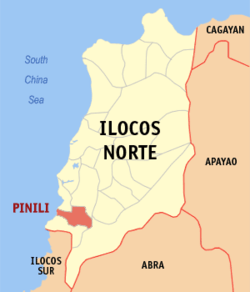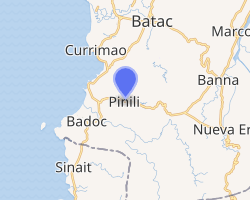Pinili
Pinili, officially the Municipality of Pinili (Ilocano: Ili ti Pinili; Filipino: Bayan ng Pinili), is a 3rd class municipality in the province of Ilocos Norte, Philippines. According to the 2015 census, it has a population of 17,300 people.[3]
Pinili | |
|---|---|
| Municipality of Pinili | |
 Seal | |
 Map of Ilocos Norte with Pinili highlighted | |
OpenStreetMap 
| |
.svg.png) Pinili Location within the Philippines | |
| Coordinates: 17°57′14″N 120°31′37″E | |
| Country | |
| Region | Ilocos Region (Region I) |
| Province | Ilocos Norte |
| District | 2nd District |
| Barangays | 25 (see Barangays) |
| Government | |
| • Type | Sangguniang Bayan |
| • Mayor | Rommel T. Labasan |
| • Vice Mayor | Maynard Francis R. Bumanglag |
| • Congressman | Eugenio Angelo M. Barba |
| • Electorate | 12,050 voters (2019) |
| Area | |
| • Total | 89.48 km2 (34.55 sq mi) |
| Population (2015 census)[3] | |
| • Total | 17,300 |
| • Density | 190/km2 (500/sq mi) |
| • Households | 3,812 |
| Economy | |
| • Income class | 3rd municipal income class |
| • Poverty incidence | 12.42% (2015)[4] |
| • Revenue (₱) | 198,779,516.94 (2016) |
| Time zone | UTC+8 (PST) |
| ZIP code | 2905 |
| PSGC | |
| IDD : area code | +63 (0)77 |
| Climate type | tropical monsoon climate |
| Native languages | Ilocano Tagalog |
| Website | www |
The place is called Pinili because Gregorio Aglipay, founder of the Philippine Independent Church, chose (pinili in Tagalog) to hide in this mountainous municipality. Aglipay has a statue in honor of him, having a bible and a revolver in his hands.
Barangays
Climate
| Climate data for Pinili, Ilocos Norte | |||||||||||||
|---|---|---|---|---|---|---|---|---|---|---|---|---|---|
| Month | Jan | Feb | Mar | Apr | May | Jun | Jul | Aug | Sep | Oct | Nov | Dec | Year |
| Average high °C (°F) | 29 (84) |
31 (88) |
32 (90) |
34 (93) |
32 (90) |
31 (88) |
30 (86) |
30 (86) |
30 (86) |
30 (86) |
30 (86) |
29 (84) |
31 (87) |
| Average low °C (°F) | 18 (64) |
19 (66) |
20 (68) |
23 (73) |
24 (75) |
24 (75) |
24 (75) |
24 (75) |
24 (75) |
22 (72) |
21 (70) |
19 (66) |
22 (71) |
| Average precipitation mm (inches) | 9 (0.4) |
11 (0.4) |
13 (0.5) |
23 (0.9) |
92 (3.6) |
122 (4.8) |
153 (6.0) |
137 (5.4) |
139 (5.5) |
141 (5.6) |
42 (1.7) |
14 (0.6) |
896 (35.4) |
| Average rainy days | 4.6 | 4.0 | 6.2 | 9.1 | 19.5 | 23.2 | 24.0 | 22.5 | 21.5 | 15.2 | 10.5 | 6.0 | 166.3 |
| Source: Meteoblue [5] | |||||||||||||
Demographics
| Year | Pop. | ±% p.a. |
|---|---|---|
| 1939 | 7,890 | — |
| 1948 | 8,318 | +0.59% |
| 1960 | 10,472 | +1.94% |
| 1970 | 12,211 | +1.55% |
| 1975 | 12,741 | +0.86% |
| 1980 | 13,521 | +1.20% |
| 1990 | 14,950 | +1.01% |
| 1995 | 14,817 | −0.17% |
| 2000 | 15,903 | +1.53% |
| 2007 | 16,185 | +0.24% |
| 2015 | 17,300 | +0.84% |
| Source: Philippine Statistics Authority[3][6][7][8] | ||
In the 2015 census, the population of Pinili was 17,300 people,[3] with a density of 190 inhabitants per square kilometre or 490 inhabitants per square mile.
gollark: I would test more, but I don't want to risk killing them with over-viewing.
gollark: It's at 6d1, was incubated, and hatched a smidgen after... 3d17h or something?
gollark: I think later, because time zone.
gollark: Aug 26, it says.
gollark: Ah, my self-viewbombed hatchling came out female.
References
- "Municipality". Quezon City, Philippines: Department of the Interior and Local Government. Retrieved 31 May 2013.
- "Province: Ilocos Norte". PSGC Interactive. Quezon City, Philippines: Philippine Statistics Authority. Retrieved 12 November 2016.
- Census of Population (2015). "Region I (Ilocos Region)". Total Population by Province, City, Municipality and Barangay. PSA. Retrieved 20 June 2016.
- "PSA releases the 2015 Municipal and City Level Poverty Estimates". Quezon City, Philippines. Retrieved 1 January 2020.
- "Pinili: Average Temperatures and Rainfall". Meteoblue. Retrieved 4 March 2020.
- Census of Population and Housing (2010). "Region I (Ilocos Region)". Total Population by Province, City, Municipality and Barangay. NSO. Retrieved 29 June 2016.
- Censuses of Population (1903–2007). "Region I (Ilocos Region)". Table 1. Population Enumerated in Various Censuses by Province/Highly Urbanized City: 1903 to 2007. NSO.
- "Province of Ilocos Norte". Municipality Population Data. Local Water Utilities Administration Research Division. Retrieved 17 December 2016.
External links
- Pinili Profile at PhilAtlas.com
- Philippine Standard Geographic Code
- Philippine Census Information
- Local Governance Performance Management System
This article is issued from Wikipedia. The text is licensed under Creative Commons - Attribution - Sharealike. Additional terms may apply for the media files.